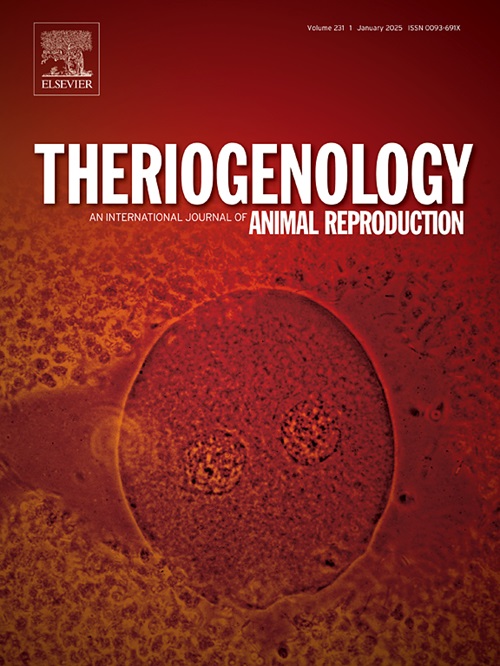体外成熟过程中补充白细胞介素-6可提高体外受精猪卵母细胞的发育能力
IF 2.4
2区 农林科学
Q3 REPRODUCTIVE BIOLOGY
引用次数: 0
摘要
白细胞介素6 (IL-6)是一种在生殖道内生理表达的细胞因子,在细胞通讯和排卵、着床等过程中起着至关重要的作用。这些过程和胚胎的存在改变了体内女性生殖道的免疫反应,这是一个极其相关的生理事件。模拟这种生理环境可以优化猪体外胚胎生产。本研究旨在评估在体外成熟(IVM)和/或体外培养(IVC)过程中添加IL-6对体外受精猪卵母细胞发育能力的影响。在第一个实验中,卵丘-卵母细胞复合物(COCs)在含有分级IL-6浓度(0-200 ng/mL)的培养基中成熟。IL-6不影响成熟、受精、卵裂或囊胚形成率。然而,100 ng/mL IL-6显著(P <;0.05)与对照组相比,改善了染色体排列、减数分裂纺锤体形成、囊胚效率和总细胞数。在第二个试验中,COCs在不添加IL-6的情况下成熟并受精。所得到的推定受精卵在具有分级浓度IL-6 (0-200 ng/mL)的IVC培养基中培养。在IVC期间补充IL-6没有提高发育能力。相反,最高IL-6浓度显著(P <;0.05)降低了卵裂率。在第三个实验中,与单独IVM期间补充IL-6相比,在IVM期间联合补充100 ng/mL IL-6和在IVC期间联合补充10 ng/mL IL-6没有额外的改善。综上所述,本研究结果表明,IL-6,特别是在卵母细胞成熟过程中添加,对猪体外胚胎的产生有积极的影响。本文章由计算机程序翻译,如有差异,请以英文原文为准。
Interleukin-6 supplementation during in vitro maturation improves developmental competence of in vitro fertilized porcine oocytes
Interleukin 6 (IL-6) is a cytokine physiologically expressed within the reproductive tract, where it plays a crucial role in cellular communication and processes such as ovulation and implantation. These processes and the presence of embryos alter the immune response of the female reproductive tract in vivo, a physiological event of utmost relevance. Mimicking such physiological environment may optimize porcine in vitro embryo production (IVP). This study aimed to assess the impact of IL-6 supplementation during in vitro maturation (IVM) and/or in vitro culture (IVC) on the developmental competence of pig oocytes fertilized in vitro. In the first experiment, cumulus-oocytes complexes (COCs) were matured in media containing graded IL-6 concentrations (0–200 ng/mL). IL-6 did not affect maturation, fertilization, cleavage, or blastocyst formation rates. However, 100 ng/mL IL-6 significantly (P < 0.05) improved chromosome alignment, meiotic spindle formation, blastocyst efficiency, and total cell number compared to controls. In the second experiment, COCs were matured and fertilized without IL-6 supplementation. The resulting presumptive zygotes were cultured in IVC media with graded concentrations of IL-6 (0–200 ng/mL). IL-6 supplementation during IVC did not enhance developmental competence. Conversely, the highest IL-6 concentration significantly (P < 0.05) reduced cleavage rate. In the third experiment, combined supplementation of 100 ng/mL IL-6 during IVM and 10 ng/mL during IVC showed no additional improvements compared to IL-6 supplementation during IVM alone. In conclusion, the results of this study indicate that IL-6, particularly when added during oocyte maturation, positively impacts porcine in vitro embryo production.
求助全文
通过发布文献求助,成功后即可免费获取论文全文。
去求助
来源期刊

Theriogenology
农林科学-生殖生物学
CiteScore
5.50
自引率
14.30%
发文量
387
审稿时长
72 days
期刊介绍:
Theriogenology provides an international forum for researchers, clinicians, and industry professionals in animal reproductive biology. This acclaimed journal publishes articles on a wide range of topics in reproductive and developmental biology, of domestic mammal, avian, and aquatic species as well as wild species which are the object of veterinary care in research or conservation programs.
 求助内容:
求助内容: 应助结果提醒方式:
应助结果提醒方式:


